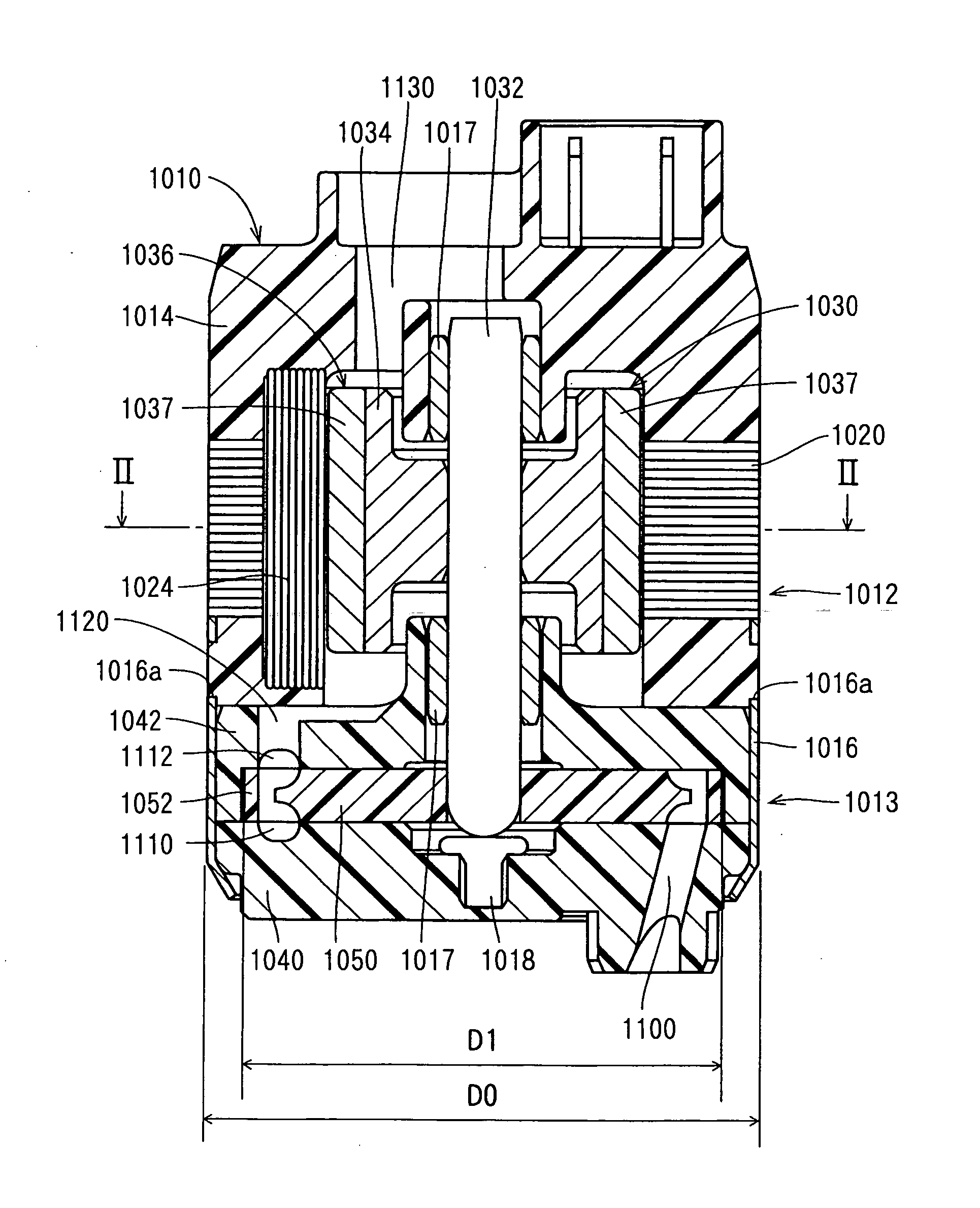Fuel pump, fuel supply equipment using fuel pump and method for manufacturing fuel pump
a fuel pump and fuel supply technology, applied in the direction of piston pumps, positive displacement liquid engines, magnetism circuit shapes/forms/construction, etc., can solve the problems of short motor life, reduced motor efficiency, and reduced motor efficiency, so as to reduce sliding resistance and fluid resistance, the effect of increasing the pressure of the fuel and increasing the curren
- Summary
- Abstract
- Description
- Claims
- Application Information
AI Technical Summary
Benefits of technology
Problems solved by technology
Method used
Image
Examples
first preferred embodiment
[0056] In FIG. 3 fuel supply equipment using the fuel pump in accordance with the first preferred embodiment of the present invention is illustrated. Afuel pump 1010 in the fuel supply equipment is an in-tank type Wesco pump mounted in a fuel tank 1001 of a motorcycle. A fuel discharging amount required in the fuel pump 1010 is 5 L / h or more to 30 L / h or less. The fuel pump 1010 discharges the fuel in the fuel in the fuel tank 1001 sucked through a suction filter 1200 while its pressure is being increased. The fuel discharged by the fuel pump 1010 passes through a check valve 1202 and a fuel pressure is adjusted by a pressure regulator 1204 and the fuel is fed to the engine acting as a fuel consuming device.
[0057] A control device 1210 for use in controlling the driving current fed to the fuel pump 1010 is fixed outside the fuel tank 1001 of the lid member 1002 for closing an opening of the fuel tank 1001. A capacity of the battery of a motorcycle not shown for feeding the driving ...
second preferred embodiment
[0069] In FIG. 7 is illustrated the second preferred embodiment. This preferred embodiment is substantially the same as the constitution of the first preferred embodiment except the fact that the pump 1060 is different from the pump 1013 in the first preferred embodiment. Substantially the same composing portions as those of the first preferred embodiment are denoted by the same reference symbols.
[0070] In the second preferred embodiment, the pump 1060 constitutes a trochoid pump. An outer rotor 1064 is stored at the inner circumferential side of the housing 1062, and an inner rotor 1066 is stored at the inner circumference of the outer rotor 1064. Inner teeth 1065 formed at the inner circumference of the outer rotor 1064 are engaged with outer teeth 1067 formed at the outer circumference of the inner rotor 1066. The center of the outer rotor 1065 is eccentric with respect to the center of the inner rotor 1066, and the number of inner teeth 1065 is larger by 1 than that of the oute...
third preferred embodiment
[0071] In FIG. 8 is shown the third preferred embodiment of the present invention. Substantially the same composing elements as those of the first preferred embodiment are denoted by the same reference symbols.
[0072] In the third preferred embodiment, a control device 1220 comprises a three-phase circuit 1230, a current detector 1240 and a PWM (Pulse Width Modulation) control part 1250. The three-phase circuit 1230 in the third preferred embodiment is substantially the same circuit as that of the control device 1210 shown in FIG. 5. The three-phase circuit 1230, the current detector 1240 and the PWM control part 1250 are constituted by one tip IC element as one circuit module.
[0073] The current detector 1240 compares a total amount of currents flowing in six coils 1024 of the fuel pump 1010 with a predetermined value and transmits the result to the PWM control part 1250.
[0074] At the PWM control part 1250 acting as a limiting circuit a corresponding table is made for the PWM valu...
PUM
 Login to View More
Login to View More Abstract
Description
Claims
Application Information
 Login to View More
Login to View More - R&D
- Intellectual Property
- Life Sciences
- Materials
- Tech Scout
- Unparalleled Data Quality
- Higher Quality Content
- 60% Fewer Hallucinations
Browse by: Latest US Patents, China's latest patents, Technical Efficacy Thesaurus, Application Domain, Technology Topic, Popular Technical Reports.
© 2025 PatSnap. All rights reserved.Legal|Privacy policy|Modern Slavery Act Transparency Statement|Sitemap|About US| Contact US: help@patsnap.com



